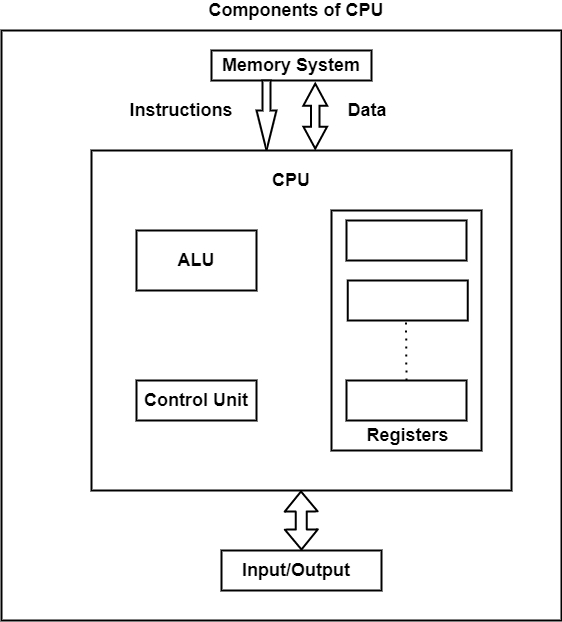
- Computer - Home
- Computer - Overview
- Computer - Advantages & Disadvantages
- Computer - Classification
- Computer - Applications
- Computer - History & Evolution
- Computer - System Characteristics
- Computing Origins
- Computer - Origins
- Computer - Generations
- Computer - Types
- Computer Components
- Computer - Components
- Computer - CPU
- Computer - CPU Components
- Computer - Arithmetic Logic Unit (ALU)
- Computer - Control Unit
- Computer - Input Devices
- Computer - Output Devices
- Computer - Memory Units
- Computer Hardware
- Computer - Hardware
- Computer - Motherboard
- Computer - GPU
- Computer - PSU
- Computer Software
- Computer - Software
- Computer - Software Types
- Computer Data Storage & Memory
- Computer - Data Storage
- Computer - Types of Data Storage
- Computer - Hard Disk Drives (HDD)
- Computer - Solid State Drives (SSD)
- Computer - Memory Cards
- Computer - Optical Storage
- Computer - NAND Flash Memory
- Computer - NVMe Memory
- Computer - CompactFlash Card
- Computer - Cloud Storage
- Computer Memory
- Computer - Memory
- Computer - Primary Memory
- Computer - Secondary Memory
- Computer - RAM
- Computer - ROM
- Computer - DRAM
- Computer - VRAM
- Computer - Cache Memory
- Computer Internet & Intranet
- Computer - Internet and Intranet
- Computer - Internet
- Computer - Extranet
- Computer - Websites
- Computer Office Tools
- Computer - Word Processors
- Computer - Spread Sheet
- Computer - Power Presentations
- Computer - E-mail Tools
- Computer Miscellaneous
- Computer - Ports
- Computer - Number System
- Computer - Number Conversion
- Computer - Data and Information
- Computer - Networking
- Computer - Operating System
- Computer - Keyboard Shortcut Keys
- Computer - Virus
- Computer - Antivirus
- Computer - How to Buy?
- Computer - Available Courses
- Calculator Vs. Computer
- Brain Vs. Computer
- Analog Vs. Digital Computer
- Supercomputer Vs. Mainframe Computer
- Mainframe Vs. Minicomputer
- Printer Vs. Scanner
- OCR Vs. MICR
- File Vs. Folder
- exFAT Vs. FAT32
- FAT32 Vs. NTFS
- FAT32 Vs. exFAT Vs. NTFS
- CPU Vs. GPU
- GUI Vs. CLI
- GUI Vs. CUI
- Cache Memory Vs. Virtual Memory
- Register Vs. Memory
- RAM Vs. CAM
- SRAM Vs. DRAM
- DDR2 Vs. DDR3
- PROM Vs. EPROM
- CD Vs. DVD
- Blu-Ray Vs. DVD
- MMU Vs. MPU
- Computer Terminologies
- Microsoft Windows
- Desktop
- Monitor
- Microphone
- Keyboard
- Keypad
- Mouse
- Printer
- Webcam
- Floppy Disk Drive
- Compact Disc
- Program
- Incognito Mode
- Electronic Mail (E-Mail)
- Server
- Cloud Hosting
- Minicomputers
- Supercomputer
- Bit
- Byte
- Kilobyte
- Megabyte
- Terabyte
- Yottabyte
- Zettabyte
- Exabyte
- Petabyte
- JEDEC
- Hub
- Block Storage
- Username
- URL
- Num Lock
- BIOS
- Bluetooth
Computer - CPU Components
CPU stands for Central Processing Unit. It is the soul of a computer system. The CPU along with the memory and the I/O sub-systems establish a strong computer system.
A CPU includes small layers of hundreds of transistors. Transistors are microscopic bits of substances that block electricity at one voltage (non-conductor) and enable electricity to move through them at multiple voltages (conductor).
These slight bits of substantial are the semiconductors that create two electronic inputs and create multiple outputs when one or both inputs are turned on.
CPU is the most significant in a computer system. It is the component that regulates all internal and external devices and implements arithmetic and logic operations to perform the set of instructions saved in the computers memory.
Components of CPU
A CPU includes three major components that are as follows

Register Set
The register set contrasts from one system to another. The register set includes several registers which contain general-purpose registers and special-purpose registers. The general-purpose registers do not implement any particular function. They save the temporary information that is needed by a program. The special-purpose registers execute various functions for the CPU.
ALU
The ALU implements all the arithmetic, logical, and shift operations by supporting important circuitry that provides these evaluations.
Control Unit
The control unit fetches the instructions from the main memory, decodes the instructions, and then executes them.
The CPU interacts with the main memory and input/output devices. The CPU reads and writes data to and from the memory system and transfers data to and from the I/O devices.
An elementary execution cycle in the CPU can be defined as follows
- The CPU fetches the instruction to be implemented from the main memory and saves it in the Instruction Register (IR).
- The instruction is decoded.
- The operands are fetched from the memory system and stored in the CPU registers.
- The instructions are then executed.
- The results are transferred from the CPU registers to the memory system.
If there are more instructions to be executed, the execution cycle repeats. Some pending interrupts are also tested during the execution cycle.
Example The interrupts including I/O device request, arithmetic overflow, or pages are tested during the execution cycle.
The procedures of the CPU are represented by the micro-orders issued by the control unit. The micro-orders are the control signals, which are transfer over-determined control lines.
CPU is the main component of a computer system. It can give out each instruction of a program to implement primary arithmetical, logical, and input/output operations.